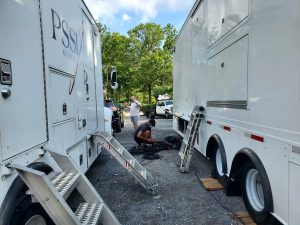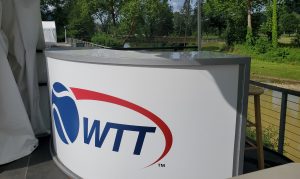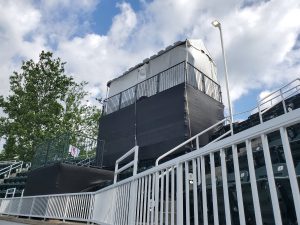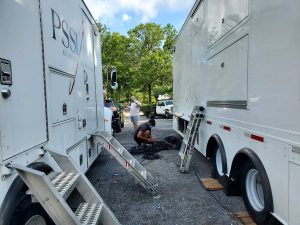World TeamTennis Returns With Marathon Tourney at The Greenbrier in West Virginia
CBS, ESPN, and Tennis Channel will carry live coverage of three-week event
Story Highlights
World TeamTennis is the latest pro league to embrace the “bubble” concept, taking over at The Greenbrier in West Virginia for a three-week season featuring nine teams and a limited number of fans in the stands. With strict health and safety guidelines in place to protect the crew, WTT’s broadcast-production team will have produced 66 matches in 19 days from the luxury resort by the time the Final airs on CBS on Aug. 2.
“It is a daunting task: we have three matches a day, sometimes four,” says WTT Executive Producer Jim Townsend. “We have an [onsite] truck environment, and we will be rotating people in and out with two crews a day. We will social-distance as best as we can, and everybody will be wearing masks. We will try to keep it [familiar to viewers], but it will be a lot different from anything we’ve ever done before.”
In addition to CBS’s first-ever broadcast of the WTT Final, the entire 66-match season will be televised or live-streamed on various platforms: CBS Sports Network carrying 13 regular-season WTT matches (plus the Semifinals on Aug. 1), ESPN2 airing 10 matches, ESPN+ live-streaming 25, Tennis Channel televising 19 matches, and the CBS Sports app and Facebook Watch live-streaming five matches.
“Across every platform, fans can watch every single match,” says World TeamTennis CEO Carlos Silva. “We’re grateful to have everyone, and I think all the broadcast partners are happy to have us as well. They’ve all been playing a lot of reruns, as we know, over the last couple of months. So I think everyone’s excited to have us in their lineups, and it’s great to have all 66 matches on.”
The Venue: WTT, The Greenbrier Make Health and Safety Top Priority
When the WTT Celebrity All-Star Match concluded on March 1, the league fully expected to return on July 12 with its traditional home-and-away model for the regular season. However, when the coronavirus pandemic rocked the sports world, WTT quickly pivoted and began searching for a central location to host the 2020 season.
“We quickly came to the realization that flying nine teams around in cities like New York, Philly, Chicago, DC, Vegas, and others was not going to happen, so we started looking at different options,” says Silva. “After looking at several [venues in] different states, The Greenbrier jumped in with a proposal that was very competitive. In hindsight, I think we probably look smart in choosing West Virginia because it remains very low in [COVID-19 cases] right now.”
WTT has rolled out Ross Production Services’ RMP6 truck to house its production team. WTT is operating two shifts of crews for all positions — an early shift and a late shift — to produce matches throughout each day. The truck is thoroughly cleaned between shifts, and all personnel are required to wear masks at all time and are assigned their own headset for the entire 19-day effort.

Ross Production Services has rolled out its RMP6 truck for the WTT productions, and PSSI is providing a sat uplink.
All personnel onsite were tested and delivered a negative result in their home city within five days of traveling to The Greenbriar and were required to complete another test on arrival. After testing negative (and being quarantined in their hotel rooms for the 24-hour testing period), they were able to enter The Greenbriar compound. In addition, they have their temperature checked when entering the stadium each day. WTT will also require a mid-season test for all players and staff. CLICK HERE for a detailed look at WTT’s safety protocols.
The WTT will be one of the rare U.S. sports events to welcome fans, permitting 500 fans per day to enter the 2,500-capacity stadium at The Greenbriar. All fans must pass a temperature test, wear masks at all times, and maintain social distance throughout the lower bowl.
In addition to the main stadium, WTT has set up a backup indoor court to ensure that all 66 matches are completed in case of inclement weather (matches can be moved inside in just 20 minutes). Fans will not be allowed access to the indoor court, but WTT has deployed a full complement of cameras to cover the matches should they move inside.
“One challenge has been long fiber and Ethernet runs across a historic property not wired for connectivity,” explains Paul Casey, SVP, engineering and technology, WTT. “However, keeping to a single venue for the season creates a lot of efficiencies. We set up our equipment twice for the season: an outdoor court setup and another indoors for weather contingency.”
On the Court: More Robos, No Camera Operators at Court Level
Court coverage is provided by nine cameras: the main game unit, a tight/follow shot, four robos (two on the court, one in the booth, one for interviews), a reverse shot, one at the host desk, and two Marshall POVs (wide shot and umpire cam). WTT made an effort to deploy minimal crew onsite and converted its low-level cameras to robos (no operators are allowed at court level) with robo operators located in a remote building far from the main compound.
“It will look different, as does everything these days, but we’re trying as hard as we can not to have it look that different,” says Townsend. “The [court-level] cameras will essentially be in the [usual] position, just operated remotely.”
On-air talent is onsite, with the play-by-play and color analyst socially distanced from each other. Instead of a sideline reporter, WTT has deployed a studio desk where a host will conduct interviews with players, who will be located in a separate room with a monitor, speaker, and boom mic.
On the audio side, WTT has deployed additional mics on the court and around the player bench area to capture more audio of the action on the court. However, given safety concerns, player mics — normally, a staple of WWT coverage — will not be used this year, but coaches will still be miked. Although a limited number of fans will be in attendance, the audio focus will remain on the action on the court.
“We’re definitely more focused on court sound, rather than crowd sound,” Townsend explains. “You can’t get crowd sounds if they don’t exist. And, unless I get told differently, I’m not going to pump crowd [noise] in, because I don’t believe in it.”
For transmission, WTT has implemented two diverse paths out: a C-band satellite uplink via PSSI/Strategic TV and an IP connection from LTN. For Tennis Channel, which takes primary and backup from LTN, WTT purchased circuits from Suddenlink and Frontier to have ISP diversity over IP. For the matches airing on CBS, WTT is backed up with a second C-band satellite truck.
“Each broadcaster has a different preference [for satellite or terrestrial] for primary and backup delivery,” says Casey. “So we’re agnostic: we provide both.”
For the full World TeamTennis broadcast/streaming schedule, CLICK HERE.




